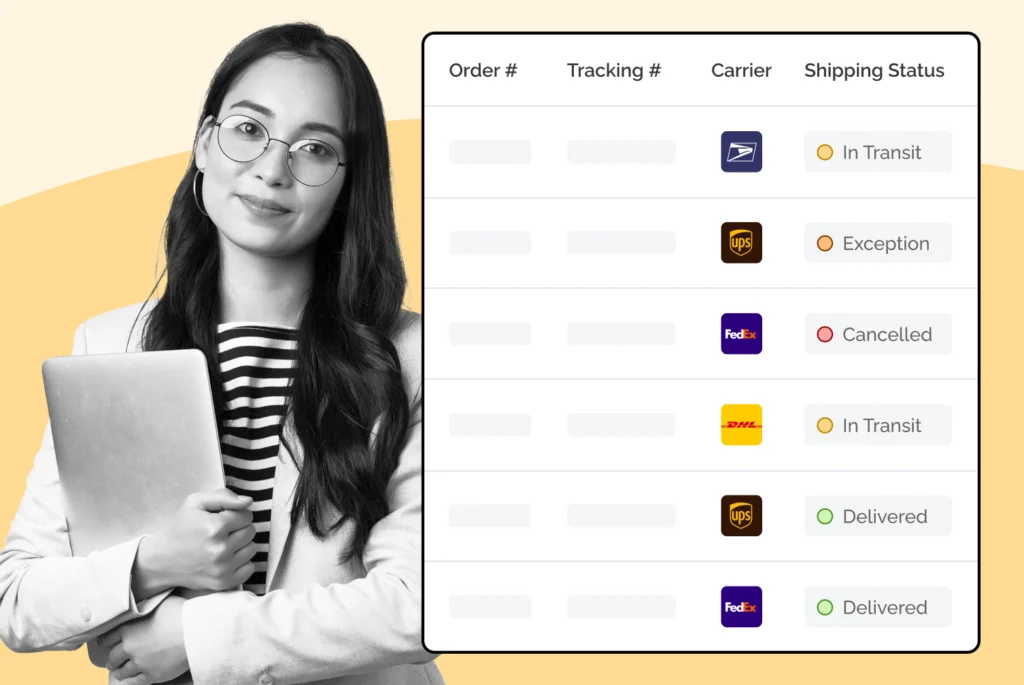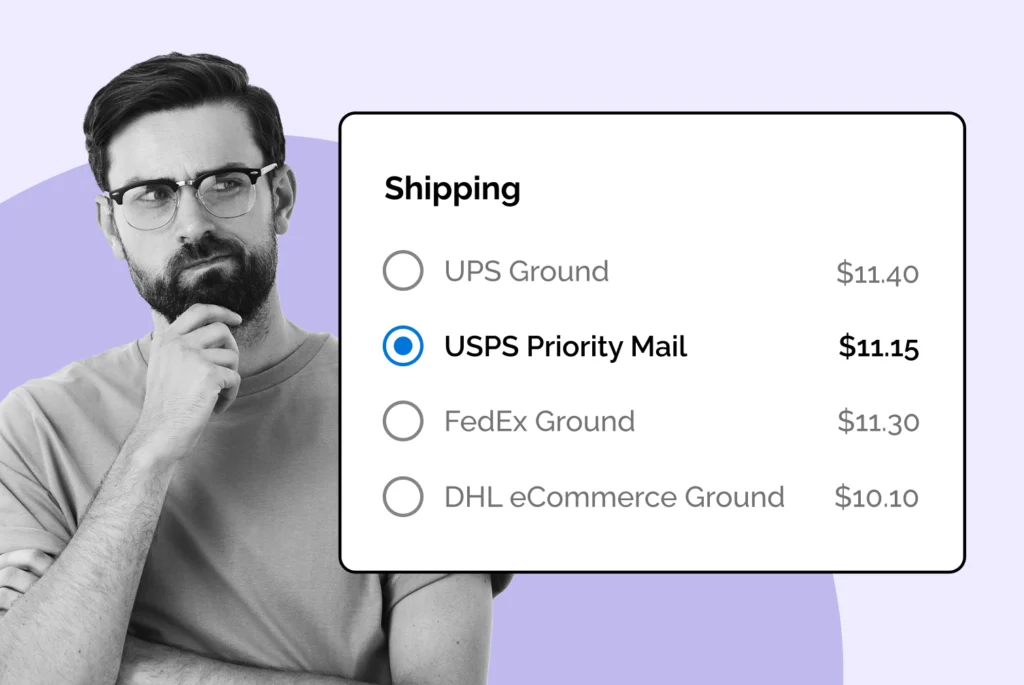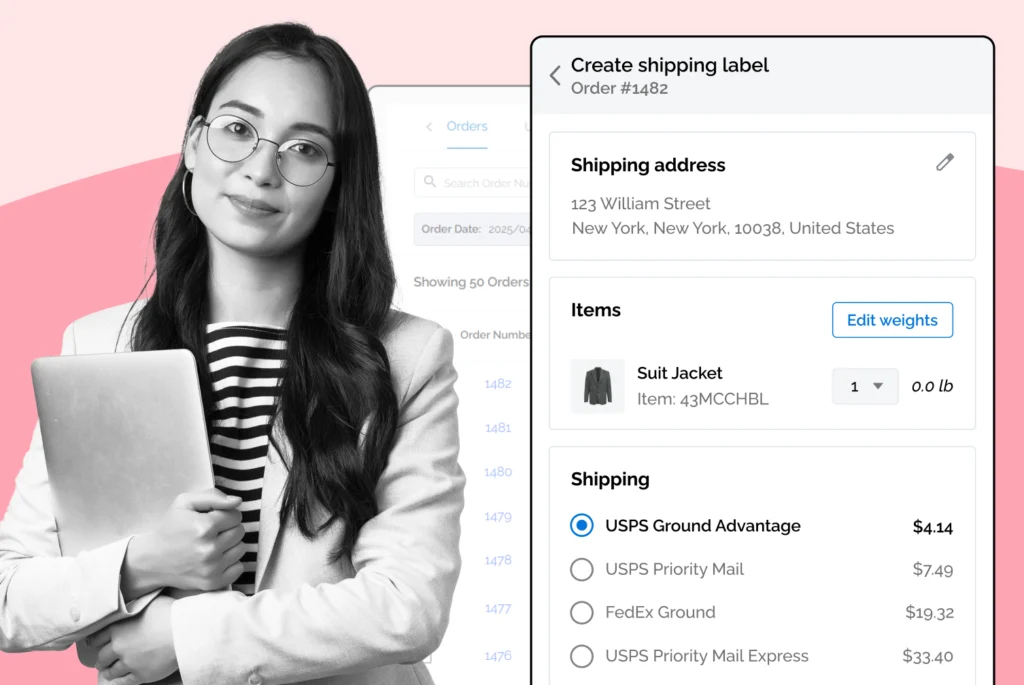
Hazardous Materials Shipping Ecommerce: How To Do It Safely
Navigate the complexities of hazardous materials shipping compliance in ecommerce. Learn essential regulations and best practices.
Shipping, Tracking & Notifications
Boost customer experience and reduce support tickets
Realtime order and shipment tracking
Proactive order and shipping notifications
AI-Enhanced Discounted Labels
Predictive pre-purchase estimated delivery dates
Self-Serivce branded order tracking
Effortless experience delivered
Identify and Resolve Order Issues
Realtime order and shipment tracking
Make returns profitable and delight customers
Flexibility to define any return destinations & conditions
Simplify returns for your customers and team
Incentivize exchanges over returns
Returns management made easy for your team
Returns management made easy for your team
Easy claims and smart upsells
Understand why your customers are returning
In-Store & Curbside Pickup
Unify the online and the in-store experience
Hassle-free pickup experience for customers
In-Store dashboard to keep operations streamlined
In-Store and Online orders unified
Drive foot-traffic to your stores
Shipping, Tracking & Notifications
Boost customer experience and reduce support tickets
Realtime order and shipment tracking
Proactive order and shipping notifications
AI-Enhanced Discounted Labels
Predictive pre-purchase estimated delivery dates
Self-Serivce branded order tracking
Effortless experience delivered
Identify and Resolve Order Issues
Realtime order and shipment tracking
Make returns profitable and delight customers
Flexibility to define any return destinations & conditions
Simplify returns for your customers and team
Incentivize exchanges over returns
Returns management made easy for your team
Returns management made easy for your team
Understand why your customers are returning
In-Store & Curbside Pickup
Unify the online and the in-store experience
Hassle-free pickup experience for customers
In-Store Dashboard to keep operations streamlined
In-Store and Online orders unified
Drive foot-traffic to your stores
Boost customer experience and reduce support tickets
Realtime order and shipment tracking
Proactive order and shipping notifications
AI-Enhanced Discounted Labels
Predictive pre-purchase estimated delivery dates
Self-Serivce branded order tracking
Effortless experience delivered
Make returns profitable and delight customers
Flexibility to define any return destinations & conditions
Simplify returns for your customers and team
Incentivize exchanges over returns
Returns management made easy for your team
Equip your team for precise return checks.
Easy claims and smart upsells
Understand why your customers are returning
Unify the online and the in-store experience
Hassle-free pickup experience for customers
In-Store Dashboard to keep operations streamlined
In-Store and Online orders unified
Drive foot-traffic to your stores
Find the answer to all your questions
Take a step by step trip through our functionality to see how we can improve your ecommerce processes.
Explore the most comon questions about WeSupply
Calculate the ROI that WeSupply can bring you
Read actionable articles on how to optimize your post-purchase experience and decrease support tickets
Get inspired by stories of how our customers implemented an effortless post-purchase experience
Wondering if WeSupply is a good fit for you? Read through our use cases to see how we can help you increase conversion & improve CX!
A Deep Dive into Top Companies' Order Tracking & Returns Strategy
Find the answer to all your questions
Explore the most comon questions about WeSupply
Calculate the ROI that WeSupply can bring you
Request a no strings attached review of your current shopping experience and missed conversion opportunities
Take a step by step trip through our functionality to see how we can improve your ecommerce processes.
Read actionable articles on how to optimize your post-purchase experience and decrease support tickets
Get inspired by stories of how our customers implemented an effortless post-purchase experience
A Deep Dive into Top Companies' Order Tracking & Returns Strategy
Wondering if WeSupply is a good fit for you? Read through our use cases to see how we can help you increase conversion & improve CX!

Global trade forms the foundation of modern commerce, connecting businesses and consumers across continents. At the heart of this vast network lies the shipping industry, responsible for moving billions of tons of goods every year. Yet, the process is anything but straightforward. Companies must navigate a complex web of risks, from supply chain disruptions and fluctuating demand to evolving compliance requirements and international regulations.
Effective risk management strategies are essential for businesses seeking to maintain timely delivery and uphold their competitive advantage. The International Maritime Organization (IMO) plays a pivotal role by establishing global standards for safety and security, ensuring that shipping operations meet rigorous compliance benchmarks. However, the challenges extend beyond regulatory adherence. Businesses must also address operational risks, anticipate disruptions, and adapt to the ever-changing landscape of global trade.
By understanding the various aspects of shipping from logistics and safety to compliance and efficiency companies can develop proactive approaches to risk management. This not only helps mitigate potential disruptions but also streamlines processes, reduces costs, and positions businesses to thrive in a competitive global market. Navigating these challenges with a strategic mindset is essential for any organization aiming to succeed in international shipping.
If you’ve ever tracked a shipment only to see it delayed for weeks, you already know how fragile the global shipping system can be. In today’s world, managing those risks is not just a back-office task it is a strategic priority. Shipping now faces a perfect storm of challenges. Geopolitical conflicts continue to close or restrict vital routes, such as the ongoing diversions around the Red Sea. Climate change has reduced water levels in major canals, slowing global trade. Cyberattacks against logistics companies are at record highs. According to the United Nations Conference on Trade and Development (UNCTAD), global maritime trade is projected to grow by only 0.5% in 2025, down from an average of 3% over the past two decades.
This slowdown is not just about ships moving more slowly; it reflects how uncertainty in shipping ripples through entire supply chains. Companies that treat risk management as an afterthought often find themselves paying higher costs, disappointing customers, and scrambling for emergency solutions. On the other hand, businesses that anticipate these risks and plan ahead can turn resilience into a competitive edge. Effective risk management is paramount for maintaining operational continuity and customer trust in global shipping.
Shipping risks fall into several categories, and it’s important to see the full picture. To effectively mitigate their impact, it is crucial to identify potential risks early in the shipping process. Operational risks include accidents at sea, port congestion, or labor strikes. Strategic risks involve political instability, trade wars, or tariffs that suddenly make a route unprofitable. Emerging risks are the ones that catch companies off guard: ransomware attacks on shipping registries, or unexpected climate events like droughts in the Panama Canal.
A single disruption can multiply across the supply chain. If a vessel is delayed, inventory runs short, factories idle, and customers lose trust. In 2021, the Ever Given blocked the Suez Canal for six days, costing global trade an estimated $9 billion per day. These kinds of shocks highlight why a deep understanding of risk factors—beyond just fuel prices or weather reports is vital.
Risk management starts with due diligence. This means carefully vetting who you work with and where your goods are moving. Many companies look only at cost when choosing a shipping partner, but reliability, compliance record, and financial health are just as important. A low-cost forwarder with weak security practices can end up being the most expensive mistake you make.
Due diligence also applies to the wider environment. Businesses must track trade policy changes, environmental regulations, and customs regulations. Adhering to customs regulations is crucial for avoiding shipment delays, penalties, and customs holds, ensuring compliance and a smooth logistics process. The European Union, for example, has introduced stricter carbon emissions reporting requirements that now affect shipping companies worldwide. Staying ahead of these changes reduces the risk of sudden fines or shipment delays. Just as importantly, companies should build internal expertise hiring or training staff who can interpret geopolitical signals and anticipate trouble before it arrives.
Many disruptions don’t come from your direct suppliers, but from the suppliers of your suppliers. This is why visibility beyond Tier 1 is essential. A Tier 2 factory in a politically unstable region may seem far away, but if it produces a small component critical to your final product, a single disruption there can halt production worldwide.
Advanced supply chain mapping tools now allow companies to trace these hidden links and assign risk scores to them. For example, after the Fukushima earthquake in 2011, many automakers realized too late that they were dependent on a handful of Japanese suppliers for key electronic parts. Those who had already mapped their networks recovered faster. The lesson is clear: you can’t manage risks you don’t see. Mapping supply chain networks enables companies to mitigate risks by identifying and addressing vulnerabilities before they escalate.
Strategic route planning and optimization are at the core of effective risk management in international shipping. The routes chosen for shipments can significantly impact the likelihood of disruptions, shipping costs, and the safe arrival of cargo at its destination. By analyzing potential risks associated with different shipping routes such as exposure to natural disasters, geopolitical instability, or capacity shortages businesses can make informed decisions that minimize vulnerabilities.
Leveraging real-time visibility tools and working closely with reliable partners allows companies to avoid high-risk areas and respond quickly to emerging threats. Technology and automation play a crucial role in this process, enabling logistics teams to monitor conditions, reroute shipments as needed, and optimize shipping operations for both efficiency and safety. Quality management practices, combined with robust cargo insurance, further reduce the risk of cargo damage and ensure that goods reach their destination safely.
By investing in advanced route planning and collaborating with logistics experts, businesses can not only reduce shipping costs and operational risks but also enhance customer satisfaction and strengthen their position in the global marketplace. Proactive route optimization is a key element of risk mitigation, helping companies navigate the complexities of international shipping with confidence.
Reduce Shipping Risks with Smarter Route planning
Book a quick call to see how WeSupply optimizes routes, prevents disruptions, and cuts shipping costs.
Combat inconvenience with proactivity & self service
Book a quick call with our experts to see how WeSupply can help you make returns easy for your customers with a beautiful, self-service solution that makes their experience easier while also providing new ways to lower costs and earn back revenue.
Scenario planning is often dismissed as a “paper exercise,” but when done properly, it becomes a powerful tool. Scenario planning is a core component of strategic risk management for global shipping. The idea is simple: imagine the worst disruptions, then stress-test your operations against them. What if a major port closes for two months? What if tariffs double overnight? What if a cyberattack locks your tracking system?
These are not far-fetched. Each of them has already happened in some form in the past decade. The value of scenario planning lies in practice. By rehearsing responses in advance, teams can react calmly and quickly when real disruptions hit. Companies that modeled a Suez Canal blockage after 2021 were better prepared when diversions around the Red Sea began in 2023–2024.
Diversification is one of the most repeated mantras in risk management but done poorly, it can become expensive and inefficient. The trick is finding the balance. Spreading sourcing across too many regions raises costs and complexity, while over-relying on a single supplier or route exposes you to big risks. Similarly, depending on one location for warehousing or fulfillment in global shipping can lead to significant delays and disruptions if that site faces issues.
Near-shoring and re-shoring have become attractive, but they are not silver bullets. Bringing production closer to home can reduce geopolitical exposure but may increase labor costs. Smart companies use a hybrid approach: keeping some production near customers while maintaining global partners for cost efficiency. The key is flexibility, not just redundancy.
The days of “just-in-time” inventory are fading, but “just-in-case” hoarding is not the answer either. Excess stock ties up capital and storage costs, especially when goods become obsolete quickly. The smarter approach is data-driven buffer inventory.
For example, during hurricane season, a U.S. electronics distributor may increase stock of long-lead-time items but keep lean levels of fast-moving goods. Predictive analytics make it possible to adjust buffers based on demand trends and seasonal risks. Well-trained warehouse staff play a crucial role in managing these inventory buffers and implementing security measures to prevent losses or mishandling of cargo. According to McKinsey, companies with advanced analytics reduced inventory-related costs by up to 15% while improving resilience.
Technology now sits at the heart of resilient shipping. Technology plays a crucial role in managing risks throughout the shipping process by enabling route planning, shipping insurance integration, real-time tracking, and carrier performance management to mitigate potential hazards. Real-time tracking systems show where vessels are and when they might be delayed. Predictive analytics flag potential bottlenecks before they happen. Digital twins virtual models of supply chains allow managers to simulate disruptions and test responses.
However, technology also introduces new risks. The shipping industry has become a target for cybercriminals. In 2017, the ransomware attack on Maersk forced the company to reinstall 4,000 servers and 45,000 PCs, costing over $300 million. For this reason, cybersecurity is no longer an IT issue but a core logistics concern. Companies must secure both their data and their partners’ systems.
Maritime security remains critical, even in the digital age. Piracy in the Gulf of Guinea, political unrest near the Strait of Hormuz, and recent drone strikes in the Red Sea all demonstrate that physical risks are alive and well, highlighting the need for ship security assessments as part of comprehensive risk management. The International Maritime Organization (IMO) sets global safety standards, but compliance depends on individual companies. Maritime safety is essential for protecting ships, crew, and cargo during global shipping operations.
Investing in training, secure procedures, and crisis protocols is not optional. Crews need to know how to respond to piracy attempts or onboard accidents. Managers must track security advisories and adjust routes accordingly. To protect both cargo and personnel, a strong security culture is necessary to safeguard all aspects of maritime operations.
No company manages risks alone. Logistics partners play a huge role in crisis response. The best forwarders and carriers offer not just transportation but expertise, backup options, and customs navigation. These partners provide comprehensive services, including risk management, security solutions, and support for port and terminal operations.
A strong partner can reroute shipments quickly during port closures or advise on alternative compliance routes when tariffs change.
Building transparent communication with suppliers and customers is just as important. If a disruption occurs, clear updates build trust and allow others to adapt. Public-private partnerships can also help, particularly in developing countries where port infrastructure and customs processes may be less reliable.
Insurance is often overlooked until it is too late, but it can be a powerful tool for managing shipping risks. Standard cargo insurance covers loss or damage, but businesses shipping high-value goods or operating in risky regions need broader coverage. Hull and Machinery insurance protects the vessel itself, Protection & Indemnity covers liabilities, and War Risk insurance is now critical in conflict-prone areas.
War risk premiums surged by as much as 300% during the Red Sea diversions in 2024, catching some companies off guard. Reviewing policies regularly ensures coverage is up to date. Insurance should not replace risk management but complement it, transferring financial liability so that disruptions do not cripple operations.
Shipping worldwide can feel like a guessing game delays, lost packages, and unexpected problems happen more often than we’d like. That’s why having the right system in place matters. WeSupply gives you the tools to take control, protect your profits, and keep your customers happy even when things don’t go as planned.
Here’s how WeSupply helps:
See everything in real time – Track every order across 1,000+ carriers worldwide. Spot problems like delays or stalled shipments before your customers do.
Keep customers in the loop – Send automatic updates by email or SMS about shipping delays, weather issues, or delivery attempts so customers never feel left in the dark.
Prevent frustration before it grows – Identify undeliverable shipments, failed delivery attempts, or returns-to-sender quickly so you can fix issues before they become costly mistakes.
Protect against lost or stolen packages – Give customers an easy way to report missing items and solve claims faster with live updates and quick resolutions.
Cut down on “Where is my order?” calls – With branded tracking pages and proactive notifications, shoppers get answers instantly without needing to reach your support team.
Lower costs and stay flexible – Access discounted shipping labels, compare carrier rates in one place, and switch carriers easily if one is experiencing delays.
Turn challenges into opportunities – Use shipment updates and branded tracking pages to share promotions, product education, or personalized recommendations that bring customers back to your store.
“What if my shipments are delayed due to weather or strikes?”
WeSupply notifies both you and your customers right away, helping you set realistic expectations and prevent negative reviews.
“How can I save money when global shipping costs keep going up?”
Through our EasyPost partnership, you get instant access to discounted rates no contracts, no minimums, just savings you can apply immediately.
“What if my orders come from different suppliers or warehouses?”
No problem. WeSupply consolidates updates from multiple carriers and locations into one clear view so you and your customers know exactly what’s arriving and when.
In uncertain times, shipping risks don’t just affect delivery they affect your reputation, your bottom line, and your customer loyalty. WeSupply helps you stay proactive, not reactive, giving your business a competitive edge when reliability matters most.
👉 Get started in just 15 minutes and see how WeSupply can transform your global shipping process.
With over 150 stores fulfilling online orders, J.McLaughlin often had to split shipments a process that left customers confused and customer service teams overwhelmed with “Where is my order?” calls. Their ERP wasn’t designed to clearly manage or communicate split shipments, leading to frustration and inefficiencies.
WeSupply stepped in to centralize all shipments into a single, branded tracking experience. Customers could now see every package, its status, tracking events, and estimated delivery date all in one place. Proactive notifications further reduced confusion, kept customers engaged, and turned shipping updates into a positive brand touchpoint.
Global shipping will always face challenges whether from conflict, weather, cyberattacks, or shifting regulations but uncertainty doesn’t have to leave you exposed.
With WeSupply, businesses gain real-time visibility across 1,000+ carriers, proactive customer notifications, discounted shipping labels, and branded tracking pages that cut costs and build trust. From resolving lost or stalled shipments to reducing “Where is my order?” calls, WeSupply empowers teams to protect profits while turning disruptions into opportunities for engagement. In today’s climate, risk management isn’t just about preventing losses it’s about using smarter tools to create resilient customer experiences.
The companies that embrace this proactive approach will not only navigate uncertainty with confidence but also win lasting loyalty in global trade.
1. What are the biggest risks in global shipping today?
The top risks include geopolitical conflicts, cyberattacks, port congestion, labor strikes, and climate-driven disruptions. These risks affect costs, delivery times, and customer trust across global supply chains.
2. How can businesses reduce risks in international shipping?
Companies mitigate risks with route optimization, advanced supply chain mapping, predictive analytics, and insurance. Proactive planning like scenario testing and inventory buffers creates resilience against disruptions.
3. Why is scenario planning critical for shipping risk management?
Scenario planning stress-tests operations against disruptions like port closures, tariffs, or cyberattacks. Businesses that prepare with simulations recover faster and avoid costly emergency responses.
4. How does WeSupply help manage global shipping delays?
WeSupply detects delays across 1,000+ carriers in real time and notifies both you and your customers instantly, preventing frustration and reducing support inquiries.
5. Can WeSupply save money on rising shipping costs?
Yes. Through EasyPost, WeSupply gives instant access to discounted carrier rates with no contracts or minimums, helping businesses lower costs while staying flexible.
6. How does WeSupply reduce customer “Where is my order?” calls?
With branded tracking pages, proactive SMS/email updates, and consolidated carrier data, customers see real-time status without contacting support.
7. Does WeSupply have an Official Shopify App?
Yes. WeSupply has an Official Shopify App. You can download it and start integrating with your Shopify Store.
8. Does WeSupply have an official Magento extension?
Yes, WeSupply has an official extension for Magento. The WeSupply x Magento integration allows for automating order tracking experiences, reducing customer inquiries, automating shipping email and SMS notifications, and providing a fully branded order tracking experience
9. Does WeSupply have an official BigCommerce App?
Yes, WeSupply has an official BigCommerce App. You can integrate WeSupply with your BigCommerce store to improve your post-purchase customer experience.
Learn How To Create Successful Post Purchase Email Campaigns
Build an effective post-purchase email flow that helps you increase customer satisfaction and drive revenue growth!

Navigate the complexities of hazardous materials shipping compliance in ecommerce. Learn essential regulations and best practices.

Explore the key benefits of multi carrier shipping for your business. Enhance efficiency, cut costs, and improve customer satisfaction.

Discover the true costs of overnight shipping as we compare rates and options. Make informed choices for your shipping needs.
Discover top real-time package tracking solutions for seamless shipping experiences. Improve your logistics today!

Discover top shipping API solutions that enhance your ecommerce fulfillment process. Simplify logistics and improve customer satisfaction.

Master post-holiday returns management with effective strategies that streamline processes and enhance customer satisfaction.

Discover the pros and cons of flat rate and standard shipping to make the best choice for your needs. Read the article now!

Boost holiday sales with AI-driven recommendations this BFCM. Discover strategies to engage customers and increase conversions.

Discover essential strategies to streamline bulk returns handling and enhance efficiency. Read the article for practical tips!